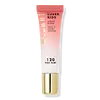What's inside
What's inside
 Key Ingredients
Key Ingredients

 Benefits
Benefits

 Concerns
Concerns

 Ingredients Side-by-side
Ingredients Side-by-side

Water
Skin ConditioningIsododecane
EmollientPEG-10 Dimethicone
Skin ConditioningButylene Glycol
HumectantDimethicone
EmollientTriethylhexanoin
MaskingDicaprylyl Carbonate
EmollientEthylhexyl Isononanoate
EmollientCetyl PEG/PPG-10/1 Dimethicone
EmulsifyingVinyl Dimethicone/Methicone Silsesquioxane Crosspolymer
Glycerin
HumectantSodium Chloride
MaskingMica
Cosmetic ColorantPhenoxyethanol
PreservativeDimethicone Crosspolymer
Emulsion StabilisingDisteardimonium Hectorite
StabilisingPolyglyceryl-2 Triisostearate
EmulsifyingSodium Dehydroacetate
PreservativeMethyl Methacrylate Crosspolymer
Ethylhexylglycerin
Skin ConditioningRosa Centifolia Flower Water
Skin ConditioningTriethoxycaprylylsilane
Citrus Medica Vulgaris Fruit Extract
AntioxidantIsopropyl Titanium Triisostearate
EmollientTriethoxysilylethyl Polydimethylsiloxyethyl Dimethicone
Skin ConditioningPunica Granatum Fruit Juice
MaskingCI 77891
Cosmetic ColorantCI 15850
Cosmetic ColorantIron Oxides
CI 19140
Cosmetic ColorantWater, Isododecane, PEG-10 Dimethicone, Butylene Glycol, Dimethicone, Triethylhexanoin, Dicaprylyl Carbonate, Ethylhexyl Isononanoate, Cetyl PEG/PPG-10/1 Dimethicone, Vinyl Dimethicone/Methicone Silsesquioxane Crosspolymer, Glycerin, Sodium Chloride, Mica, Phenoxyethanol, Dimethicone Crosspolymer, Disteardimonium Hectorite, Polyglyceryl-2 Triisostearate, Sodium Dehydroacetate, Methyl Methacrylate Crosspolymer, Ethylhexylglycerin, Rosa Centifolia Flower Water, Triethoxycaprylylsilane, Citrus Medica Vulgaris Fruit Extract, Isopropyl Titanium Triisostearate, Triethoxysilylethyl Polydimethylsiloxyethyl Dimethicone, Punica Granatum Fruit Juice, CI 77891, CI 15850, Iron Oxides, CI 19140
Isocetyl Stearoyl Stearate
EmollientGlycerin
HumectantTribehenin
EmollientSambucus Nigra Fruit Extract
AstringentMica
Cosmetic ColorantGlyceryl Stearate
EmollientGlycyrrhiza Glabra Root Extract
BleachingSilica
AbrasiveMorus Alba Root Extract
BleachingSymphytum Officinale Leaf Extract
Skin ConditioningOenothera Biennis Root Extract
Skin ConditioningTitanium Dioxide
Cosmetic ColorantCI 77891
Cosmetic ColorantIron Oxides
CI 15985
Cosmetic ColorantCI 15850
Cosmetic ColorantCI 45380
Cosmetic ColorantCI 77510
Cosmetic ColorantIsocetyl Stearoyl Stearate, Glycerin, Tribehenin, Sambucus Nigra Fruit Extract, Mica, Glyceryl Stearate, Glycyrrhiza Glabra Root Extract, Silica, Morus Alba Root Extract, Symphytum Officinale Leaf Extract, Oenothera Biennis Root Extract, Titanium Dioxide, CI 77891, Iron Oxides, CI 15985, CI 15850, CI 45380, CI 77510
 Reviews
Reviews

Alternatives
Ingredients Explained
These ingredients are found in both products.
Ingredients higher up in an ingredient list are typically present in a larger amount.
Ci 15850 is the pigment color red. It is an azo dye and created synthetically.
Azo dyes need to be thoroughly purified before use. This allows them to be more stable and longer-lasting.
This ingredient is common in foundations, lipsticks, and blushes. This color is described as brown/orangey red.
It has many secondary names such as Red 6 and Red 7. According to a manufacturer, Red 6 usually contains aluminum.
Learn more about CI 15850Ci 77891 is a white pigment from Titanium dioxide. It is naturally found in minerals such as rutile and ilmenite.
It's main function is to add a white color to cosmetics. It can also be mixed with other colors to create different shades.
Ci 77891 is commonly found in sunscreens due to its ability to block UV rays.
Learn more about CI 77891Glycerin is already naturally found in your skin. It helps moisturize and protect your skin.
A study from 2016 found glycerin to be more effective as a humectant than AHAs and hyaluronic acid.
As a humectant, it helps the skin stay hydrated by pulling moisture to your skin. The low molecular weight of glycerin allows it to pull moisture into the deeper layers of your skin.
Hydrated skin improves your skin barrier; Your skin barrier helps protect against irritants and bacteria.
Glycerin has also been found to have antimicrobial and antiviral properties. Due to these properties, glycerin is often used in wound and burn treatments.
In cosmetics, glycerin is usually derived from plants such as soybean or palm. However, it can also be sourced from animals, such as tallow or animal fat.
This ingredient is organic, colorless, odorless, and non-toxic.
Glycerin is the name for this ingredient in American English. British English uses Glycerol/Glycerine.
Learn more about GlycerinMica is a naturally occurring mineral used to add shimmer and color in cosmetics. It can also help improve the texture of a product or give it an opaque, white/silver color.
Serecite is the name for very fine but ragged grains of mica.
This ingredient is often coated with metal oxides like titanium dioxide. Trace amounts of heavy metals may be found in mica, but these metals are not harmful in our personal products.
Mica has been used since prehistoric times throughout the world. Ancient Egyptian, Indian, Greek, Roman, Aztec, and Chinese civilizations have used mica.
Learn more about MicaThis ingredient is a combination of red, black, and yellow iron oxide pigments. This combination of colors is usually found in foundation, because it results in a "skin" color.